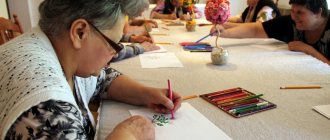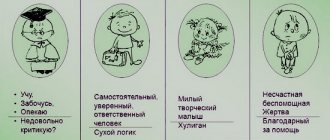It has long been known in psychology that in their creativity people express feelings and thoughts through images in one way or another. Therefore, the drawing reflects individuality and allows you to learn more about a person, his personal characteristics and problems. The patterns noticed by scientists can be used for self-diagnosis. Draw a tree on a piece of paper, and then analyze your action using prompts
General impression
If you couldn’t complete the drawing for a long time and tried to correct and redo something, then your desires are contradictory. You live with a feeling of internal conflict. If you couldn’t finish drawing the tree at all, then this is an indicator of overwork and weakness. Thin lines in the drawing, made with almost no pressure, indicate self-absorption, concentration on one’s own experiences, and may also indicate a depressive state and physical weakness.
Confidence of lines and clarity in the image are a sign of resistance to stress.
If there is a lot of shading in the drawing, then you lack self-confidence. You are, in all likelihood, an anxious, suspicious and often doubtful person.
If you draw poorly (not everyone can be a great artist), but at the same time brought the work to its logical conclusion, then your strengths are determination, perseverance and faith in your own strength.
Tree.
Tree test.
Invite the subject to draw a tree on an A4 sheet of paper using colored pencils. Don't tell me how to draw or help.
Interpretation*
The height of the tree in the figure is the real age of the person being tested. How old is a tree? How old does a person feel? Contradictions here often manifest themselves in forms of behavior, especially in stressful situations, people are expected to behave at one age, but they constantly demonstrate at another. As a result, an incorrect and contradictory assessment of a person’s personality arises.
1. The roots of the tree are the past (family ties).
Connection with the earth, with nutrition, restoration, nature.
A hidden element of wood, but at the same time its basis, material support. Strong roots - appear in older age, memories of the past, family roots, dependence on the family, in neurotics - an accentuated view of the past. The influence of family scripts. Emotional and spiritual connection with relatives and predecessors. Does a person feel support from relatives, does he feel the need to find his “roots” and their stability. The roots are thin, do not touch the ground or rest on its surface
- a suspended state, contact with reality is limited.
The roots are larger than the tree
- unbalanced, the unconscious prevails over the conscious.
No roots
- no support from others, a feeling of loneliness, despite the presence of relatives. Deep down he feels that he cannot rely on them in emotional and practical matters, that they can let him down. Lack of trust even in oneself - the highest degree of manifestation of the symbol - the absence of roots and underlining this with a line, separation from the soil by a line - one feels isolated and unhappy.
2. Barrel – real – body.
The trunk is personal potential.
The core basis of the personality, showing the existence of the basic ideas of the personality. Only the trunk and crown are the desire for philosophizing. A trunk with a pointed top
means the presence of a specific goal to which a person’s life is dedicated both consciously and unconsciously.
The top of the trunk hidden by the foliage
is a nebula of the final goal; it is not visible or there is no need for it.
The orientation of the personality is not defined. The trunk is absent or very thin, blackened
- health problems.
A weak trunk
means a feeling of disembodiment, separation from the ground, such people do not survive.
If the species is oak, then this is a need, an ideal. Shading of the trunk - neurotic tendencies. The trunk is bent
- a tendency to regression and over-compensatory fixation in the future.
A stump or trunk with the top cut off
is a breakdown in personality associated with the loss of guidelines for mental development.
A broken tree
is a breakdown, a feeling of emptiness of existence.
The tree bent over, almost touching the ground
- the pressure of the outside world.
Tilt – intense doubt, can move from one state to another, is emotionally changeable, may not follow recommendations. A tree is like a keyhole, with a crown in the form of a circle or an oval, the junction with the trunk can be closed or not,
the trunk is like two vertical lines, connected or not at the base - strong hostility.
Longitudinal stripes on the trunk
- alarm.
General tension, anxiety, emotional problems with parents, sadness from abandonment, sometimes anger. Typical for children with emotional deprivation in the family. Long shading with light pressure means neurotic, lack of self-confidence. Hollow
- divorce, the arrival of a stepfather in the family, someone's death.
Boughs, broken branches, hollow
- ruptures, divorces, psychological trauma.
3. Crown - the future
Crown structure
– the degree of desire to obtain satisfaction from the surrounding world.
If the crown is not drawn, it is an unfilled space. The crown is outlined by a line
- an attempt to control emotions. If individual branches break out beyond the line, the attempt is unsuccessful.
Perseverations as an outline of the crown -
inflation of thoughts generated by fear, hatred of coercion, low self-esteem, self-criticism as an absorbing process, fear.
Perseveration is a stereotypical repetition in a person of any mental image, action, statement or state. A lot of leaves, a rich crown like a woman’s hair
- a sense of self: there is a lot of me, self-confidence.
A high self-evaluation. An ethereal tree
- very thin lines, the trunk disappears - a separation from the physical body, from reality, does not stand on the ground, “such people cannot survive”, if the tree is an oak - then compensation, the need for a strong partner.
The sun above the tree
- the need for authority, for guardianship.
Clouds in the sky
are generalized anxiety associated with relationships in the surrounding reality.
The shadow of a tree on the ground
is anxiety on a conscious level, the experience of unsatisfied relationships in the past.
Conscious level - like a shadow on the ground. Additionally, absent-mindedness – if there is a shadow but no sun. Here the sun is energy. Mushrooms, bushes
,
everything under the tree
- the environment - family, children, what relieves anxiety, does not feel naked.
Arrangement of the territory - the desire to surround oneself, protect, relieve anxiety. What he surrounds himself with and controls himself with. Trees or bushes next to a tree
are people, usually family members; the distance to them is closeness or distance in relationships.
4. Landscape around a tree
Sensitive to small details, imaginative and emotional, these people feel and respond to emotional nuances of influence rather than to the whole picture.
Deep insecurity, skillfully disguised and introduced into the defense system, so that it would be difficult for others to unravel his weak points. Afraid to reveal himself. Because he believes that this will cause a negative attitude towards himself. A minimum of details
means a minimum degree of contact with the external environment, or ignoring traditions.
If, together with a minimum of details, there is a low qualitative level of proportional spatial relationships, then there is low intellectual performance. The need for quantity of details
is a sign of an irresistible need to structure the situation, excessive anxiety associated with the environment - anxiety, self-doubt.
A lonely tree at the top
- loneliness and the desire for autonomy, a feeling of uselessness, even if there is a landscape around it.
Flowers, nests, stairs
- observation, easy character, aestheticism, vanity, love of being visible, recognized by others, love of fantasy and relaxation.
5. Ground line
A sign of insecurity, a need for structuring, this line provides a starting point that ensures stability.
1) Rising up from left to right - a premonition of inevitable difficulties in the future
2) Goes down from left to right - the future is doubtful and fraught with danger. The depth of feeling is determined by the degree of inclination
3) Down from the drawing in any direction - a feeling of loneliness and uncertainty.
4) directly - separation of the animal part (roots) from the rational part of the personality, which reflects some uncertainty and distrust of emotionality, creative or spontaneous activity, protection from spontaneity through the manifestation of intellectual abilities.
The traced soil means the need for support.
6. Tree top, branches
Fork instead of crown
– uncertain prospects, perhaps open conflicts.
The bare blackened top
means fear of the future, pessimistic tendencies, personal impasse.
The branched crown
is a choice.
Unfinished crown
- uncertainty about the future
-
a pessimistic outlook, a feeling of a dead end.
Broken branches
- I could have followed this path, but I didn’t.
Branches –
the sphere of contacts, the level of activity in the search for satisfaction.
The degree of flexibility of branches, their number and relationships - adaptability, personal resources. Look at the number of large branches - these are the problems that a person is currently solving. Two-dimensional branches that do not hide the trunk
- rigidity, uncompromisingness, it is possible that the willingness to face any circumstances directly and firmly is a reaction caused by basic insecurity.
The branches do not connect to the trunk
- a deviation from the norm.
The branches go beyond the contour
- the person is trying to control his emotions.
A worm wears away a tree
- a somatic disease (ulcer, gynecology) or doubt experienced on an emotional level.
A tree in a swamp or near water rots - a tendency towards alcoholism.
7. Seasons
Summer
– the norm, an even background of mood.
Autumn
– depressive tendencies.
Winter
- severe depression, emotional problems, loneliness, lack of contacts.
Spring
is about emerging from an illness, from a somatic illness, a feeling of new strength when emerging from a crisis, and hope.
8. Breeds
Pine, spruce, larch. IN
high self-esteem, need for high evaluation. The desire to feel superior to others. High aspirations, a tendency towards an intellectual perception of the body, reduced sensitivity. Protective character. A person is prone to dominance, he has expressed organizational abilities and is quite active in action.
Apple tree
.
In men - dependence on the mother, maybe alcoholism, if there is a large apple tree with large apples.
The mother's script and strong dependence on her, often internal. Internal unfreedom from the mother. In a man - lack of independence, immaturity, dependence on the mother.
Palm trees, ficus.
Demonstrativeness, exotic conditions of existence that a person requires to create for himself. Palm tree – desire to travel.
Oak trees. E
pileptoidity.
Birch.
Anxiety, asthenic tendencies. Hypochondria. Low self-esteem.
Linden.
Epileptoidism. Rigidity, tendency to stick to something
Weeping, willow.
Psychasthenic, if the branches are directed downward - a muted state of emotions. Lack of courage, despair, motivated or unmotivated by life
Cypress.
Schizoid.
Maple
– Demonstrativeness
Poplar, ash
– male identity
9. Drawing dimensions
Very small – a feeling of inferiority, a desire to avoid reality, limited interactions with the surrounding reality, states of tension.
Very tall tree
– dependence on the surrounding reality. Shows a tendency towards aggression.
Huge crown, small trunk
- lack of independence, a feeling of basic inferiority combined with an intense desire to receive pleasure from the world around us.
Tiny young shoots emerging from a large bare trunk
- healing. Cutting off the top of the head with the edge of the sheet is a desire to find satisfaction in fantasy, abandoning the search for it in reality.
The tree touches the edge of the page
– manifestation of aggressive-reactive tendencies, which can be either suppressed or not.
10. Position of the drawing on the sheet. Alignment
- feeling of insecurity and rigidity.
Upper left corner
– anxiety, regression, avoidance of new experiences, desire to return to the past.
Cutting off the left edge of the drawing with the end of the sheet
is a fixation on the past along with fear of the future.
Cutting off the right edge of the drawing with the end of the sheet
is a desire to be in the future in order to get away from the past.
Using the bottom edge of the leaf as a base
is a generalized insecurity, a depressive - colored state.
The use of space to the left of the center of the sheet is
the dominance of the emotional sphere.
The use of space to the right of the center of the sheet is
the dominance of the intellect.
Layout on sheet
is associated with the level of aspirations - in the upper third of the sheet there are high aspirations, and in the lower third there are low aspirations. Adequate - if the large drawing is in the center of the sheet. This indicates self-confidence, but not one’s own idealization - the desire to prove oneself, to receive encouragement, high praise, but not at any cost.
Elevation above the midline
- the desire to inflate one’s own importance despite lack of recognition from others.
Bottom edge of sheet
– lack of self-confidence, low self-esteem, depression, indecisiveness, lack of interest in one’s position in society, in recognition, lack of tendency to self-affirmation.
11. Line type
Fat
– tension, fixation on individual details of the picture. The thick line of the earth is anxiety caused by relationships in real life.
Weak
– inferiority, indecisiveness, fear of defeat, reluctance to draw some details.
Jerky
- accuracy, scrupulousness; if he draws very slowly - pathoformity.
Rigid straight lines
– internal rigidity.
Curved
- rejection of conventions and restrictions.
(The tree should have curved and straight lines). The outline is strongly outlined
- “armor”, tension, the desire to keep everything under control.
Turning the leaf
- independence of mind, prudence, in therapy the emphasis is on logical justification and the rational component of emotional impact.
A lot of trees
– childish behavior, not following instructions.
*Attention, this interpretation is not a diagnosis; comments on the test and discussion are best done with your personal psychologist!
Layout on sheet
If the tree is large and takes up about three-quarters of the leaf, then you have a positive outlook on the world around you. You are an active and energetic person.
If the tree is small, you lack vital energy, you are trying to hide from possible problems.
If you don’t have enough space for a tree, then this is a sign of your breadth of nature, wealth of imagination and great possibilities.
A tree leaning to the left indicates impulsiveness. You know how to be happy with what you have, but sometimes you are frightened by the future and upset by the inability to return the past.
A tree leaning to the right reveals that you are a person of strong emotions and a rich inner life. But at the same time you know how to control yourself.
Correct administration of the projective drawing test
The child should not experience any physical or moral discomfort while working on the test.
Work can be carried out both in a group and individually. The only caveat is that if the technique is implemented in a team, then there should not be more than 4 people in the association. By the way, many psychologists defend their position that the most appropriate form of work is still individual, since in this case the experimenter has the opportunity to ask some leading questions.
For work, the subject receives a sheet of A4 paper and a hard-soft pencil, so that in the future they can evaluate the force of pressure on the sheet. The diagnostic algorithm is as follows:
- The experimenter, at his own discretion, determines which model of conduct is more productive. First: the child is given a sheet folded into an accordion shape three times (usually this is used with younger children). In this case, each object will be depicted on separate spreads. Second model: allow the subject to place all three illustrations on flat paper (in this case, several new and important aspects appear for interpretation - the distance of a particular object, pressure, and so on).
- Then the adult recommends: “Draw the house, tree and person the way you want.”
- While performing the task, the test organizer must record all comments, conditions and other external manifestations of the test taker. Such observation will be especially important for a psychologist in case the test subject exhibits deviations.
- After completing the drawing, an individual conversation is held. An adult can ask the child to explain who he drew, and also find out whether the character is in a good mood, what affects his well-being, and why the subject likes the depicted character the most.
The test time is limited only formally - 20–30 minutes. Usually children cope with the task faster.
For an objective analysis, the experimenter must carefully observe all the child’s manifestations during the drawing process.
Crown features
A rounded crown is a sign of emotionality and openness.
If it consists of curved lines, then you are a realist and a pragmatist. You also know how not to give in to negativity and cope with challenges.
A crown consisting of circles signals that you lack positivity in your life.
Smooth lines are an indicator of a realistic view of people and events.
A crown formed of circles also suggests that you lack the company of people who love and appreciate you. This makes it difficult to feel needed and protected.
The zigzag lines of the crown reveal a prudent and reserved nature.
What is this test called “Karl Koch tree”?
The author, Swiss psychologist Karl Koch, developed it in the 1950s, and this test is widely used by psychologists to assess a person's personality and emotional state. The test is often used for children over 6 years of age, but it is also great for adults.
Online publication Exploring Your Mind says the main benefit of the test is that it is ideal for different age groups, and its results help psychologists collect important data about how people perceive themselves and their lives.
You might be interested in: Test: Only 1% of people can see the animal in the picture
Barrel lines
If the trunk is straight and evenly tapers upward, then you are an enterprising and optimistic person. When problems arise, you know how to find the best way to resolve them. If it’s crooked, then you lack courage and activity.
If the trunk quickly narrows from the wide base upward, then the adversities suffered in childhood still dominate you.
A clear connection between the trunk and branches is a sign of a high intellectual level and a rich inner world. If there is a hollow in a tree, then there is an unhealed wound in your soul. And if any animal sticks out of the hollow, then you are lonely.
What can you analyze with this test?
An article in Exploring Your Mind explains it this way:
“It requires us to draw a picture, choose colors, and create an object on a blank page. This drawing can help us understand our condition, sensitivity, vulnerability, the absence or presence of internal conflicts, as well as mental and emotional stability in life.”
According to psychoanalysts (2015 study), the Karl Koch test can even help diagnose cognitive impairment and dementia.
How to decipher the Koch tree test
When analyzing the test, you need to carefully consider the following details in the tree image:
Branch outlines
Thick and clearly drawn branches are a harmonious combination of intelligence and energy. You can give your best in your activities and take all the benefits from life.
Branches with thorns reveal hidden fears and the desire to defend oneself. Volumetric branches reveal you as a sociable person, with the makings of a leader.
Pointed upward is a sign of enthusiasm and dedication.
Drooping or drooping branches are often evidence of confusion and despondency.
Branches going in different directions are usually depicted by those who do not know how to focus on one thing and rush around.
The predominance of branches on the left side indicates that in your actions you are more often guided by reason than by feelings. If there are more branches on the right, you are tempted by quick results with a minimum of effort.
Leaf texture
Lacy, patterned foliage indicates the ability to charm. You can overcome obstacles through personal charm.
The veins on the leaves indicate softness, suggestibility, inertia, diligence and perseverance.
Disproportionately large leaves indicate an inability to distinguish the main from the secondary. You are a serious, scrupulous and responsible person, but overly critical of yourself. Foliage on which no branches are visible betrays a hostile attitude towards others.
Flowers, fruits and roots
A flowering tree is a sign of satisfaction with life. And the fruits reveal those who know how to set the right goal and achieve success, regardless of the circumstances.
If your tree has no visible roots, then you are trying to isolate yourself from the outside world and seem to be floating in the clouds, periodically losing your sense of reality.
If the roots are clearly defined and go underground from the trunk, you have a close connection with your relatives. And you yourself are probably the keeper of the family hearth.
Characteristics of the psychological technique “House, tree, person”
Each person is a separate, specific personality that will not exist again. People differ in the very essence of the soul; their similarity is only external. The more someone becomes himself, the deeper and clearer his original features appear.
Valery Bryusov, Russian poet, novelist and playwright
A projective test for obtaining personality characteristics “House, tree, person” was proposed in the late 40s of the twentieth century by the American neuropsychologist J. Book. Initially, it was used to study the limits of an individual’s performance in production, as well as to determine the characteristics of his relationship with the team, which was the most important at that time. However, over time, Beech’s followers adapted this technique for children, and also somewhat simplified the diagnostic procedure. The objectives of the study are to assess:
- personal qualities of the subject;
- level of mental development;
- socialization among peers (especially important for children who enter kindergarten).
As for the age of the subjects, the test can be carried out for the first time with a child after he or she reaches 3–4 years of age, when the child has already formed elementary ideas about the rules for depicting objects.
Tree species
If you depicted a specific tree, this fact should also be taken into account.
Birch communicates femininity, goodwill, balance, spiritual generosity and love of life.
The willow is considered a symbol of traditional family values. This means that you know how to balance your desires and capabilities. You also have considerable potential in the area you have chosen to build a career.
Oak indicates strength of spirit and the ability to maintain mental balance.
Spruce is the tree of those who love holidays and are able to create them themselves. Other characteristic qualities include loyalty, self-esteem and courage.
Maple is a tree of wise, tactful and energetic people. Usually these are the people people turn to for advice and support.
Linden indicates kindness and vulnerability. You have a keen eye and are able to notice things that others do not notice.
Palma - you can’t get bored and stay in one place for a long time.
Weeping willow - you need to feel the shoulder of a reliable and strong person nearby.
Pine is a tree of obligatory, reliable and constant people. You are a great friend and a great employee.
The apple tree is considered a family tree. He is portrayed by those who love their loved ones and live in an atmosphere of mutual understanding and happiness.
If your tree is whimsical and abstract, then you are a romantic and a dreamer.
Any defects in the tree (cut down, diseased, etc.) indicate the presence of serious problems. These may include feelings of guilt, feelings of inferiority and vulnerability, helplessness, and spiritual emptiness.
If, instead of one tree, several are drawn, then you are not used to following established rules and are always ready to defend your own point of view. You have enthusiasm, carelessness, a bit of adventurism and optimism.
Test interpretation
The tree symbolizes the vital forces of human development.
Essential details:
- Trunk;
- More than one branch.
3 important steps
which every woman should go through
Anika Snagovskaya
Author and presenter of women's trainings on harmonizing feminine energy. Master of removing limiting beliefs and master of constellations.
I have prepared three lessons for you that will help you better understand yourself, remove the restrictions that prevent you from feeling loved and living happily.
01
Video lesson with meditation: 5 states of femininity
You will learn about 5 female states that exist in every woman, how they manifest themselves and which archetypes are most manifested in you and which are not developed.
02
Video lesson + meditation: How to let go of past relationships
I’ll tell you what you need to do to free your heart from old feelings and break the energy threads connecting you with your past partner.
03
Audio recording: Neuro-af
Thanks to this neuro-affirmation, you can regain self-love and feel sincere gratitude and happiness for every day.
✕
Top 3 useful materials that will help you know yourself better
And start a new, happy life for yourself.
Video lesson with meditation: 5 states of femininity
Video lesson + meditation: How to let go of past relationships
Audio recording: Neuro-af
Take your gifts!
Let’s immediately discuss two options for depicting a tree, when formally the task is completed, but in essence it is a refusal to analyze one’s own vital development. Options:
- Drawing of a Christmas tree in the form of sticks;
- Drawing of a Christmas tree.
The difference between them is only in demonstrating the mood that this topic evokes. In the first case - depressive, in the second - deliberately joyful.
Meaningful features
Tree dimensions
| Characteristic | Decoding |
| Small | Dependence on others, lack of independence |
| Big | The desire to attract attention |











